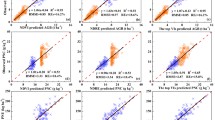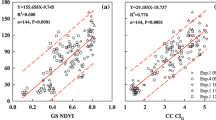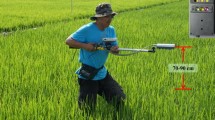Abstract
Active canopy sensors (ACSs) are great tools for diagnosing crop nitrogen (N) status and grain yield prediction to support precision N management strategies. Different commercial ACSs are available and their performances in crop N status diagnosis and recommendation may vary. The objective of this study was to determine the potential to minimize the differences of two commonly used ACSs (GreenSeeker and Crop Circle ACS-430) in maize (Zea mays L.) N status diagnosis and recommendation with multi-source data fusion and machine learning. The regression model was based on simple regression or machine learning regression including ancillary information of soil properties, weather conditions, and crop management information. Results of simple regression models indicated that Crop Circle ACS-430 with red-edge based vegetation indices performed better than GreenSeeker in estimating N nutrition index (NNI) (R2 = 0.63 vs. 0.50–0.51) and predicting grain yield (R2 = 0.56–0.57 vs. 0.49). The random forest regression (RFR) models using vegetation indices and ancillary data greatly improved the prediction of NNI (R2 = 0.81–0.82) and grain yield (R2 = 0.87–0.89), regardless of the sensor type or the vegetation index used. Using RFR models, moderate degree of accuracy in N status diagnosis was achieved based on either GreenSeeker or Crop Circle ACS-430. In comparison, using simple regression models based on spectral data only, the accuracy was significantly lower. When these two ACSs were used independently, they performed similarly in N fertilizer recommendation (R2 = 0.57–0.60). Hybrid RFR models were established using vegetation indices from both ACSs and ancillary data, which could be used to diagnose maize N status (moderate accuracy) and make side-dress N recommendations (R2 = 0.62–0.67) using any of the two ACSs. It is concluded that the use of multi-source data fusion with machine learning model could improve the accuracy of ACS-based N status diagnosis and recommendation and minimize the performance differences of different active sensors. The results of this research indicated the potential to develop machine learning models using multi-sensor and multi-source data fusion for more universal applications.






Similar content being viewed by others
References
Abdel-Rahman, E., Ahmed, F., & Ismail, R. (2013). Random forest regression and spectral band selection for estimating sugarcane leaf nitrogen concentration using EO-1 Hyperion hyperspectral data. International Journal of Remote Sensing, 34, 712–728. https://doi.org/10.1080/01431161.2012.713142.
Abraham, A., Pedregosa, F., Eickenberg, M., Gervais, P., Mueller, A., Kossaifi, J., Gramfort, A., Thirion, B., & Varoquaux, G. (2014). Machine learning for neuroimaging with scikit-learn. Frontiers In Neuroinformatics, 8, 14. https://doi.org/10.3389/fninf.2014.00014
Bean, G. M., Kitchen, N. R., Camberato, J. J., Ferguson, R. B., Fernandez, F. G., Franzen, D. W., Laboski, C. M., Nafziger, E. D., Sawyer, J. E., Scharf, P. C., Schepers, J., & Shanahan, J. S. (2018). Improving an active-optical reflectance sensor algorithm using soil and weather information. Agronomy Journal, 110, 1–11. https://doi.org/10.2134/agronj2017.12.0733
Campbell, J. B. (2002). Introduction to remote sensing (3rd ed.). The Guilford Press.
Cao, Q., Miao, Y., Feng, G., Gao, X., Li, F., Liu, B., Yue, S., Cheng, S., Ustin, S. L., & Khosla, R. (2015). Active canopy sensing of winter wheat nitrogen status: An evaluation of two sensor systems. Computers and Electronics in Agriculture, 112, 54–67. https://doi.org/10.1016/j.compag.2014.08.012
Cao, Q., Miao, Y., Feng, G., Gao, X., Liu, B., Liu, Y., Li, F., Khosla, R., Mulla, D. J., & Zhang, F. (2017). Improving nitrogen use efficiency with minimal environmental risks using an active canopy sensor in a wheat-maize cropping system. Field Crops Research, 214, 365–372. https://doi.org/10.1016/j.fcr.2017.09.033
Cao, Q., Miao, Y., Li, F., Gao, X., Liu, D., Lu, D., & Chen, X. (2017). Developing a new crop circle active canopy sensor-based precision nitrogen management strategy for winter wheat in North China Plain. Precision Agriculture, 18(1), 1–17. https://doi.org/10.1007/s11119-016-9456-7
Cao, Q., Miao, Y., Shen, J., Yuan, F., Cheng, S., & Cui, Z. (2018). Evaluating two crop circle active canopy sensors fro in-season diagnosis of winter wheat nitrogen status. Agronomy, 8, 201. https://doi.org/10.3390/agronomy8100201
Chlingaryan, A., Sukkarieh, S., & Whelan, B. (2018). Machine learning approaches for crop yield prediction and nitrogen status estimation in precision agriculture: A review. Computers and Electronics in Agriculture, 151, 61–69. https://doi.org/10.1016/j.compag.2018.05.012.
Corti, M., Cavalli, D., Cabassi, G., Marino Gallina, P., & Bechini, L. (2018). Does remote and proximal optical sensing successfully estimate maize variables? a review. European Journal of Agronomy, 99, 37–50. https://doi.org/10.1016/j.eja.2018.06.008
Everingham, Y., Sexton, J., Skocaj, D., & Inman-Bamber, G. (2016). Accurate prediction of sugarcane yield using a random forest algorithm. Agronomy for Sustainable Development, 36, 1–9. https://doi.org/10.1007/s13593-016-0364-z.
Franzen, D. W., Miao, Y., Kitchen, N. R., Schepers, J. S., & Scharf, P. C. (2021). Sensing for health, vigor and disease detection in row and grain crops. In R. Kerry & A. Escolà (Eds.), Sensing approaches for precision agriculture. progress in precision agriculture. Springer. https://doi.org/10.1007/978-3-030-78431-7_6
Ghasemi, J., & Tavakoli, H. (2013). Application of random forest regression to spectral multivariate calibration. Analytical Methods, 5, 1863–1871. https://doi.org/10.1039/C3AY26338J.
Han, L., Yang, G., Dai, H., Xu, B., Yang, H., Feng, H., Li, Z., & Yang, X. (2019). Modeling maize above-ground biomass based on machine learning approaches using UAV remote-sensing data. Plant Methods, 15, 1–19. https://doi.org/10.1186/s13007-019-0394-z
Hashimoto, N., Saito, Y., Maki, M., & Homma, K. (2019). Simulation of reflectance and vegetation indices for unmanned aerial vehicle (UAV) monitoring of paddy fields. Remote Sensing, 11, 2119. https://doi.org/10.3390/rs11182119.
Holloway, J., & Mengersen, K. (2018). Statistical machine learning methods and remote sensing for sustainable development goals: A review. Remote Sensing, 10(9), 1365. https://doi.org/10.3390/rs10091365.
Hornung, A., Khosla, R., Reich, R., Inman, D., & Westfall, D. (2006). Comparison of site-specific management zones: Soil color based and yield based. Agronomy Journal, 98, 405–417. https://doi.org/10.2134/agronj2005.0240.
Jeong, J. H., Resop, J. P., Mueller, N. D., Fleisher, D. H., Yun, K., Butler, E. E., Timlin, D. J., Shim, K. M., Gerber, J. S., Reddy, V. R., & Kim, S. H. (2016). Random forests for global and regional crop yield predictions. PLoS One, 11, e0156571. https://doi.org/10.1371/journal.pone.0156571
Klompenburg, T., Kassahun, A., & Catal, C. (2020). Crop yield prediction using machine learning: A systematic literature review. Computers and Electronics in Agriculture, 177, 105709. https://doi.org/10.1016/j.compag.2020.105709.
Landis, J. R., & Koch, G. G. (1977). The measurement of observer agreement for categorical data. Biometrics, 33, 159–174. https://doi.org/10.2307/2529310.
Lemaire, G., Jeuffroy, M. H., & Gastal, F. (2008). Diagnosis tool for plant and crop n status in vegetative stage. Theory and practices for crop n management. European Journal of Agronomy, 28(4), 614–624. https://doi.org/10.1016/j.eja.2008.01.005.
Li, F., Miao, Y., Zhang, F., Cui, Z., Li, R., Chen, X., Zhang, H., Schroder, J., Raun, W. R., & Jia, L. (2009). In-season optical sensing improves nitrogen-use efficiency for winter wheat. Soil Science Society of America Journal, 73(5), 1566–1574. https://doi.org/10.2136/sssaj2008.0150
Li, W., He, P., & Jin, J. (2012). Critical nitrogen curve and nitrogen nutrition index for spring maize in North-East China. Journal of Plant Nutrition, 35, 1747–1761. https://doi.org/10.1080/01904167.2012.698354.
Li, F., Miao, Y., Feng, G., Yuan, F., Yue, S., Gao, X., Liu, Y., Liu, B., Ustin, S. L., & Chen, X. (2014). Improving estimation of summer maize nitrogen status with red edge-based spectral vegetation indices. Field Crops Research, 157, 111–123. https://doi.org/10.1016/j.fcr.2013.12.018
Li, D., Miao, Y., Ransom, C. J., Bean, G. M., Kitchen, N. R., Fernández, F. G., Sawyer, J. E., Camberato, J. J., Carter, P. R., Ferguson, R. B., Franzen, D. W., Laboski, C. A. M., Nafziger, E. D., & Shanahan, J. F. (2022). Corn Nitrogen Nutrition Index Prediction improved by integrating genetic, environmental, and management factors with active canopy sensing using machine learning. Remote Sensing, 14, 394. https://doi.org/10.3390/rs14020394
Lu, J., Miao, Y., Shi, W., Li, J., & Yuan, F. (2017). Evaluating different approaches to non-destructive nitrogen status diagnosis of rice using portable rapidscan active canopy sensor. Scientific Reports, 7(1), 14073. https://doi.org/10.1038/s41598-017-14597-1
Lu, N., Zhou, J., Han, Z., Li, D., Cao, Q., Yao, X., Tian, Y., Zhu, Y., Cao, W., & Cheng, T. (2019). Improved estimation of aboveground biomass in wheat from RGB imagery and point cloud data acquired with a low-cost unmanned aerial vehicle system. Plant Methods, 15, 1–16. https://doi.org/10.1186/s13007-019-0402-3
Lu, J., Miao, Y., Shi, W., Li, J., Hu, X., Chen, Z., Wang, X., & Kusnierek, K. (2020). Developing a proximal active canopy sensor-based precision nitrogen management strategy for high-yielding rice. Remote Sensing, 12, 1440. https://doi.org/10.3390/rs12091440
Lu, J., Dai, E., Miao, Y., & Kusnierek, K. (2022). Improving active canopy sensor-based in-season rice nitrogen status diagnosis and recommendation using multi-source data fusion with machine learning. Journal of Cleaner Production, 380, 134926. https://doi.org/10.1016/j.jclepro.2022.134926.
Miao, Y., Khosla, R., & Mulla, D. J. (Eds.). (2022). Remote sensing for precision nitrogen management. MDPI, Switzerland Retrieved from https://www.mdpi.com/books/book/6326-remote-sensing-for-precision-nitrogen-management)
Miao, Y., Stewart, B. A., & Zhang, F. (2011). Long-term experiments for sustainable nutrient management in China. A review. Agronomy for Sustainable Development, 31(2), 397–414. https://doi.org/10.1051/agro/2010034.
Mistele, B., & Schmidhalter, U. (2008). Estimating the nitrogen nutrition index using spectral canopy reflectance measurements. European Journal of Agronomy, 29(4), 184–190. https://doi.org/10.1016/j.eja.2008.05.007.
Nelson, W. D., & Sommers, E. L. (1973). Determination of total nitrogen in plant material. Agronomy Journal, 65, 109–112. https://doi.org/10.2134/agronj1973.00021962006500010033x.
Olfs, H. W., Blankenau, K., Brentrup, F., Jasper, J., Link, A., & Lammel, J. (2005). Soil- and plant-based nitrogen-fertilizer recommendations in arable farming. Journal of Plant Nutrition and Soil Science, 168, 414–431. https://doi.org/10.1002/jpln.200520526.
Pantazi, X. E., Moshou, D., Alexandridis, T., Whetton, R. L., & Mouazen, A. M. (2016). Wheat yield prediction using machine learning and advanced sensing techniques. Computers and Electronics in Agriculture, 121, 57–65. https://doi.org/10.1016/j.compag.2015.11.018.
Pedregosa, F., Varoquaux, G., Gramfort, A., Michel, V., Thirion, B., Grisel, O., Blondel, M., Prettenhofer, P., Weiss, R., Dubourg, V., Vanderplas, J., Passos, A., Cournapeau, D., Brucher, M., Perrot, M., & Duchesnay, E. (2011). Scikit-learn: Machine learning in python. Journal of Machine Learning Research, 12, 2825–2830. https://doi.org/10.5555/1953048.2078195
Shaver, T. M., Kruger, G. R., & Rudnick, D. R. (2017). Crop canopy sensor orientation for late season nitrogen determination in corn. Journal of Plant Nutrition, 40, 2217–2223. https://doi.org/10.1080/01904167.2017.1346681.
Sishodia, R. P., Ray, R. L., & Singh, S. K. (2020). Applications of remote sensing in precision agriculture: A review. Remote Sensing, 12(19), 3136. https://doi.org/10.3390/rs12193136.
Tan, C., Zhang, P., Zhou, X., Wang, Z., Xu, Z., Mao, W., Li, W., Huo, Z., Guo, W., & Yun, F. (2020). Quantitative monitoring of leaf area index in wheat of different plant types by integrating NDVI and Beer-Lambert law. Scientific Reports, 10, 929. https://doi.org/10.1038/s41598-020-57750-z
Teal, R. K., Tubana, B., Girma, K., Freeman, K. W., Arnall, D. B., Walsh, O., & Raun, W. R. (2006). In-season prediction of corn grain yield potential using normalized difference vegetation index. Agronomy Journal, 98(6), 1488–1494. https://doi.org/10.2134/agronj2006.0103
Tremblay, N., Wang, Z., & Belec, C. (2007). Evaluation of the Dualex for the assessment of corn nitrogen status. Journal of Plant Nutrition, 30, 1355–1369. https://doi.org/10.1080/01904160701555689.
Wang, L. A., Zhou, X., Zhu, X., Dong, Z., & Guo, W. (2016). Estimation of biomass in wheat using random forest regression algorithm and remote sensing data. The Crop Journal, 4(3), 212–219. https://doi.org/10.1016/j.cj.2016.01.008.
Wang, X., Miao, Y., Dong, R., Chen, Z., Guan, Y., Yue, X., Fang, Z., & Mulla, D. J. (2019). Developing active canopy sensor-based precision nitrogen management strategies for maize in northeast China. Sustainability, 11, 706. https://doi.org/10.3390/su11030706
Wang, X., Miao, Y., Dong, R., Zha, H., Xia, T., Chen, Z., Kusnierek, K., Mi, G., Sun, H., & Li, M. (2021). Machine learning-based in-season nitrogen status diagnosis and side-dress nitrogen recommendation for corn. European Journal of Agronomy, 123, 126193. https://doi.org/10.1016/j.eja.2020.126193
Weiss, M., Jacob, F., & Duveiller, G. (2020). Remote sensing for agricultural applications: A meta-review. Remote Sensing of Environment, 236, 111402. https://doi.org/10.1016/j.rse.2019.111402.
Xia, T., Miao, Y., Wu, D., Shao, H., Khosla, R., & Mi, G. (2016). Active optical sensing of spring maize for in-season diagnosis of nitrogen status based on nitrogen nutrition index. Remote Sensing, 8, 605. https://doi.org/10.3390/rs8070605.
Yao, Y., Miao, Y., Huang, S., Gao, L., Ma, X., Zhao, G., Yang, W., & Zhu, H. (2012). Active canopy sensor-based precision n management strategy for rice. Agronomy for Sustainable Development, 32(4), 925–933. https://doi.org/10.1007/s13593-012-0094-9
Yu, C., Huang, X., Chen, H., Godfray, H. C. J., Wright, J. S., Hall, J. W., Gong, P., Ni, S., Qiao, S., Huang, G., Xiao, Y., Zhang, J., Feng, Z., Ju, X., Ciais, P., Stenseth, N. C., Hessen, D. O., Sun, Z., Yu, L., … Taylor, J. (2019). Managing nitrogen to retore water quality in China. Nature, 567, 516–520.
Zha, H., Miao, Y., Wang, T., Li, Y., Zhang, J., Sun, W., Feng, Z., & Kusnierek, K. (2020). Improving unmanned aerial vehicle remote sensing-based rice nitrogen nutrition index prediction with machine learning. Remote Sensing, 12, 215. https://doi.org/10.3390/rs12020215
Acknowledgements
The research was supported by Norwegian Ministry of Foreign Affairs (Grant Nos. SINOGRAIN II, CHN-17/0019), Minnesota Department of Agriculture/Agricultural Fertilizer Research and Education Council (Grant No. MDA/AFREC R2023-9) and the USDA National Institute of Food and Agriculture (Grant No. State project 1016571). We also would like to thank the help from Professor Guohua Mi, Tingting Xia Yanjie Guan, Xuezhi Yue, and Zheng Fang during the field experiments.
Author information
Authors and Affiliations
Corresponding author
Ethics declarations
Conflict of interest
The authors declare no conflict of interest.
Additional information
Publisher’s Note
Springer Nature remains neutral with regard to jurisdictional claims in published maps and institutional affiliations.
Rights and permissions
Springer Nature or its licensor (e.g. a society or other partner) holds exclusive rights to this article under a publishing agreement with the author(s) or other rightsholder(s); author self-archiving of the accepted manuscript version of this article is solely governed by the terms of such publishing agreement and applicable law.
About this article
Cite this article
Wang, X., Miao, Y., Dong, R. et al. Minimizing active canopy sensor differences in nitrogen status diagnosis and in-season nitrogen recommendation for maize with multi-source data fusion and machine learning. Precision Agric 24, 2549–2565 (2023). https://doi.org/10.1007/s11119-023-10052-6
Accepted:
Published:
Issue Date:
DOI: https://doi.org/10.1007/s11119-023-10052-6




